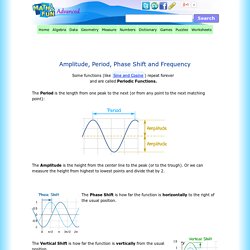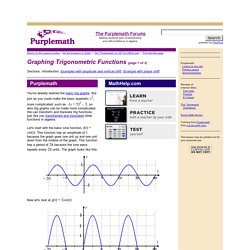

1.Summary of Amplitude, Period, Phase Shift and Frequency and Graph sketching. Some functions (like Sine and Cosine) repeat forever and are called Periodic Functions.

The Period is the length from one peak to the next (or from any point to the next matching point): The Amplitude is the height from the center line to the peak (or to the trough). Or we can measure the height from highest to lowest points and divide that by 2. The Phase Shift is how far the function is horizontally to the right of the usual position. The Vertical Shift is how far the function is vertically from the usual position.
All Together Now! We can have all of them in one equation: y = A sin(Bx + C) + D amplitude is A period is 2π/B phase shift is −C/B vertical shift is D Example: sin(x) This is the basic unchanged sine formula. So amplitude is 1, period is 2π, there is no phase shift or vertical shift: Example: 2 sin(4x − 2) + 3 amplitude A = 2 period 2π/B = 2π/4 = π/2 phase shift −C/B = −(−2)/4 = 1/2 vertical shift D = 3 In words: Note the Phase Shift formula −C/B has a minus sign: And we get: Frequency. 2.Symmetry. We tend to think about symmetry in terms of geometry more than anything else.

That's understandable; it's easy to fold shapes in half in different ways, to see if they match up. Well, functions can have symmetry too, and trig functions are like the sumo symmetry champs. There are two types of symmetry when we look at trig functions. Let's start by looking at y = cos x. It has symmetry over the y-axis. We don't have to look at a graph to show that a function is even. F(-x) = f(x) Take off the blindfold and take another look at the graph. We can check that cosine fits the equation by looking at the unit circle.
A(ll) S(ine) T(angent) C(osine). The absolute value of cos a and cos (-a) will be the same, because they have the same reference angle. This Looks Odd To Us If there exists something called "even" functions, is it really any surprise that there are odd functions as well? 3.Graphing Trigonometric Functions of form Y=asinbx+c (read pg1-3)
Graphing Trigonometric Functions (page 1 of 3) Sections: Introduction, Examples with amplitude and vertical shift, Example with phase shift You've already learned the basic trig graphs.

But just as you could make the basic quadratic x2, more complicated, such as –(x + 5)2 – 3, so also trig graphs can be made more complicated. We can transform and translate trig functions, just like you transformed and translated other functions in algebra. Let's start with the basic sine function, f(t) = sin(t). Now let's look at g(t) = 3sin(t): Do you see that the graph is three times as tall? 4.Solving Trigonometric equations of the form sin(ax+b)=c. Introduction The solution of trigonometric equations is one topic that students have particular problems with.

There are a few reasons for this: 1. there is usually a simplify part first that requires use of some TRIG identities. 2. there is the use of RADIANS rather than degrees, for which some students are not at ease with. 3. there is the repetitive aspect of TRIG functions that students find bewildering. All in all, a potentially daunting topic. To be honest though, there is nothing that you need fear here, so long as you take it methodically and slowly. Also, you have to understand what it is you are doing. Solving the TRIG Equation Of the 3 topics listed above, I am concentrating on part 3, here in this Lesson. First thing, when solving a TRIG equation, is to understand or accept that each of SINE, COSINE and TANGENT have 2 angles that will satisfy the given equation within any 360 degree range. Basics This is difficult to explain, with no real picture to use, so bear with me. Done! 5.Video Tutorial Ma301 .MOV(double click to view) 6. Assessment for Learning(double click to access the webpage)
Task II : Justification for choice of online material - Google Docs.